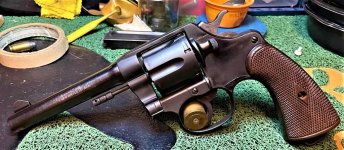"A S&W 45 ACP cylinder is the same OD as a 45 colt cylinder, the stop notches are in the same location. They will both contain the same pressure. As far as the frame goes it is the exact same frame as the model 29. The 45 colt does have a larger volume. The SAMII standard is because they have to consider all the nearly 150 year old colt revolvers in 45 colt. NOT because of any weakness in modern S&W revolvers chambered for it."
"Originally Posted by
Arkfarmer
 ...I've always wondered is how is the mod 25 frame different than the mod 29 that takes far more aggressive pressure in stride... John
...I've always wondered is how is the mod 25 frame different than the mod 29 that takes far more aggressive pressure in stride... John
It's the cylinder, specially the stop/lock notch thickness, you need to be concerned with first in this comparison."
"At it's thinnest point the cylinder lock notch of a S&W 45 revolver (either 45ACP or 45 Colt) averages .030" thick (outside chamber wall thickness minus the lock notch's depth).
On a S&W 44 Magnum it averages .040" thickness.
That's ~25% less in metal thickness for the 45 to contain the chamber pressures."
Interesting. Makes sense that an N frame, is an N frame, is an N frame be it .357, .41 Mag, .44 Spec, .44 Mag or the .45's. Is the cylinder window the same size for all N frames? Is the cylinder diameter the same for all N Frames? If the diameter is the same I assume notch location and timing are the same?









